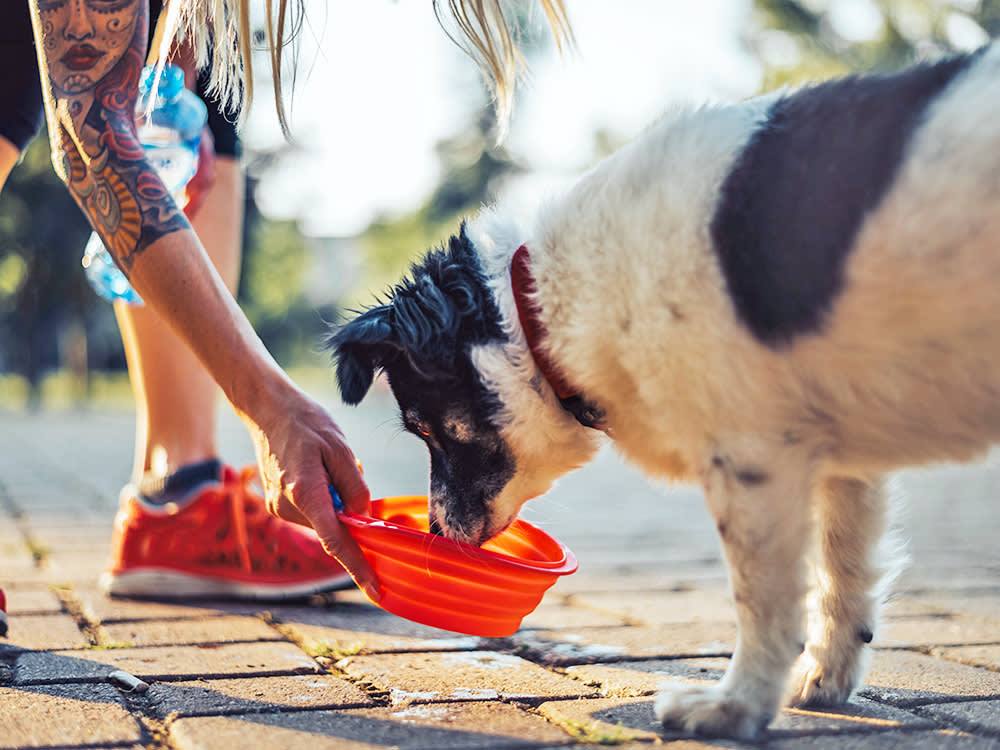We Know That Forever Chemicals Are Bad For Us—But What About Our Pets?
Unpacking the research on whether PFAs pose a health risk to our besties.

Share Article
PFAS (short for per- and-polyfluoroalkyl substances) are a class of man-made chemicals that have unique water, oil, and heat-resistant properties. They’ve long been used to coat non-stick pans, give cosmetics their glossy sheen, and make fabrics more durable. These days, you can find PFAS on food wrappers, clothing, shoes, furniture, flooring, and a bunch of other things that you — and your pet — interact with all the time.
There are thousands of different types of PFAS, and at least some of them appear to pose risks to humans. But what about our dogs and cats?
Here’s what we know so far about how pets get exposed to PFAS, how the persistent substances impact their health, and how you can protect your pet from these “forever chemicals.”
Why have PFAS been in the news lately?
People have been using products with PFAS for over 80 years, but it wasn’t until the turn of the century that we realized they might carry health risks. It all started when a farmer in West Virginia filed a claimopens in new tab against a nearby manufacturing plant for contaminating the local water supply with PFAS. This accusation set off decades of lawsuitsopens in new tab that forced researchers to start studying the effects of PFAS more closely.
How much do you spend on your pet per year?

So far, their findings have been troubling: PFAS exposure has been associatedopens in new tab with weakened immunity, changes in thyroid hormone, liver disease, kidney disease, some cancers, and reproductive issues in people of all ages.
Unfortunately, because these chemicals have been used in products for so long, they’re nearly impossible to avoid in day-to-day-life. And because they’re so persistent, they’ve contaminated our environment to the point that they can now be found in even the most remote of landscapes — from Arctic fjordsopens in new tab to deep ocean trenchesopens in new tab.
In response, this spring the U.S. EPA announced plans to limit the amount of certain PFAS allowed in public drinking wateropens in new tab. But progress is slow (only six individual PFAS are regulated under the new rule) and we have a long way to go before these chemicals are phased out entirely.
Are PFAS harmful to pets?
It’s worth noting that the first signal that PFAS might be dangerous didn’t come from a human, but from a cow. The West Virginian farmer filed his lawsuit after noticing his cattle were getting sick from unknown causes.
This shows that animals, too, seem to be affected by the class of chemicals — and it could be a cautionary tale for pet parents everywhere.
Last summer, Michigan State University kicked off a PFAS in Petsopens in new tab study to locate the likely sources of PFAS in homes and learn more about how PFAS affect pets’ health.
For the study, veterinary nurses took samples of three potential sources of PFAS from 28 Western Michigan households (dust from vacuum cleaners, water from pet bowls, and a bit of pet food). They also drew a small amount of blood from each household’s indoor cat and/or dog. From there, the samples were tested to see how many forever chemicals were present in pets’ systems — and how they may have gotten there.
“We found that PFAS levels were very similar between pets and people,” Heather Brake, the board-certified veterinarian behind the study, tells us. (The results from pets were compared to human PFAS exposure sampling recently conducted in the same regionopens in new tab.) “This shows me that whatever is being picked up in people is also being picked up in our pets.”
Research in other parts of the country tells a similar story: In a 2020 study on pet fecesopens in new tab, cats and dogs in New York tested positive for 87 percent of PFAS measured (13 out of 15 chemicals). Contributing researcher Kurunthachalam Kannan explains that dog waste had larger amounts of PFAS than cat waste in this study, though the age and gender of pets did not seem to make a difference in PFAS levels.
How PFAS exposure impacts pets’ health is still up for debate. “In terms of relating sensitivity, we still don’t know,” says Kannan. “Pets may be more sensitive to chemical exposures [than humans] — it’s not clear at this stage.”
However, preliminary results from the MSU research suggest PFAS affect pets much like they do people. “When we tested blood from our dog and cat participants, we saw some of the same changes in liver enzymes, thyroid hormones, and electrolytes that are found in people,” explains Brake. This adds to previous research that has found a potential link between PFAS and hyperthyroidism in catsopens in new tab and cholesterol issues in dogsopens in new tab.
“Though we did see changes,” Brake says. “The changes were very minor and probably wouldn’t be noticeable in our pet's daily health.” She also notes that the study had a small sample size, so more data is needed. This summer, she and her team are working on a follow-up study involving over 300 pets.
She’s hopeful that the growing body of research will help veterinarians learn to identify the top signs and symptoms of PFAS-related illness. Until then, pet parents can take matters into their own hands by reducing PFAS exposure at home as much as possible.
A PFAS checklist for pet parents
It’s safe to say that no matter what you (or your pet) do, you’re going to be exposed to PFAS at some point. “We know that PFAS are used for many, many different things — cosmetics, waxes, polishes — and so in that way, it's almost impossible to get away from them,” Brake says.
Some level of exposure is bound to happen, but there are still ways to keep your household levels on the lower side. Use this PFAS checklist to get started:
Use a water filter: Even with the new regulations, tap water will likely continue to be a source of PFAS contamination in American households. Checking out your local water quality reportopens in new tab (or getting your water tested if you’re on a private system) can give you a sense of whether PFAS are a concern for your area. If they are, consider investing in a filter that’s third-party certified to remove PFAS from the water that you and your pets drink. (Consumer Reportsopens in new tab has a great list.)
Stay on top of dusting: Dust is composed of chemicals shed from flooring, textiles, and furniture — making it another likely source of PFAS at homeopens in new tab. You’ll never be able to get rid of it entirely, nor should you try. Just do your best to wipe down your floors, dusty corners, and any other areas where your pets tend to play in order to minimize exposure.
Opt for untreated fibers: Furniture, clothes, and household goods that are labeled as “waterproof,” “stain-repellent,” or “dirt-repellant” likely have been treated with PFAS chemicals. Opt for untreated options when you can, stocking up on some pet-friendly cleaners while you’re at it.
Let your pet outside when you can: PFAS concentrations tend to be higher indoors than outdoorsopens in new tab, so if you have an outdoor pet, do your best to let them get fresh air as much as possible. Bonus points if you join them!
Be choosy with pet food: Finally, heavy-duty pet food bagsopens in new tab can also be a source of PFAS. Look out for sustainably packaged options or try your hand at making your own dog treats or cat food every once in a while. (Just be sure to talk to your vet before making any major diet changes.)
Plenty of questions remain about how PFAS affect pet health. It likely depends on the types of PFAS they’re exposed to, the length and extent of exposure, and their health history. The best thing we can do as pet parents is to advocate for more research into this mind-bogglingly vast category of chemicals, and try to minimize exposure at home (without driving ourselves bonkers).
References:
‘Forever Chemical’ Lawsuits Could Ultimately Eclipse the Big Tobacco Settlementopens in new tab
Packaging Material Suppliers Commit to PFAS-Free Futureopens in new tab

Emma Loewe
Emma is a writer, editor, and environmentalist based in New York City. She is the senior sustainability editor at MindBodyGreen, the author of Return To Nature: The New Science of How Natural Landscapes Restore Us (April 2022), and the co-author of The Spirit Almanac: A Modern Guide To Ancient Self-Care. Her writing has appeared in Grist, National Geographic, Civil Eats, and Outside Magazine, among others. While she doesn’t have any pets of her own, she is a loving dog aunt to Pip the pup.
Related articles
![eco-friendly pet parent pets down inside of indoor garden]()
How to Be an Eco-Friendly Pet Parent
Reducing your paw print can seem daunting. Consider these simple tips.
![Beagle dog fetching a green rope in a dog-proofed living room.]()
How to Dog-Proof Your Home
Our room-to-room guide to get your house in dog-safe shape.
![Staffordshire bull terrier dog eating grass]()
15 Things You Think Are Toxic for Dogs — But Actually Aren’t
From (human) prescription meds to poinsettia plants, these "toxic" items may not be so bad for your pup.
![Hiker and dog overlooking the top of a mountain]()
8 Ways to Be a More Eco-Friendly Pet Parent in 2025
Expert tips to help reduce your pet’s carbon footprint. (Pawprint? You get it.)
![Cat sitting on a kitchen chair, looking at the camera]()
How to Cat-Proof Your House
Ten steps for keeping your cat out of trouble.
![A couple cooking in the kitchen while the guy feeds part of their meal to their Great Dane dog]()
How to Shop For Healthy, Eco-Friendly Ingredients to Feed Your Dog
From regenerative meats to low-carbon grains, these sustainable foods are fit for any conscious canine.








